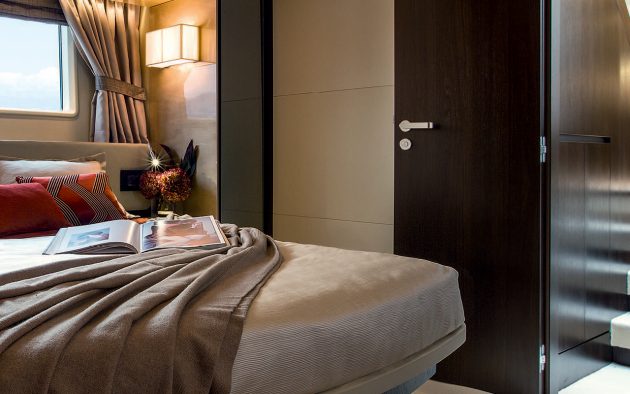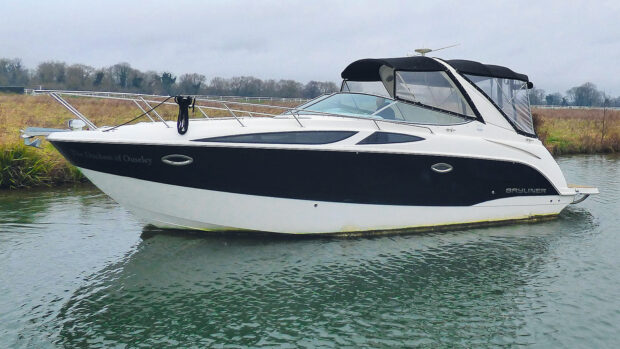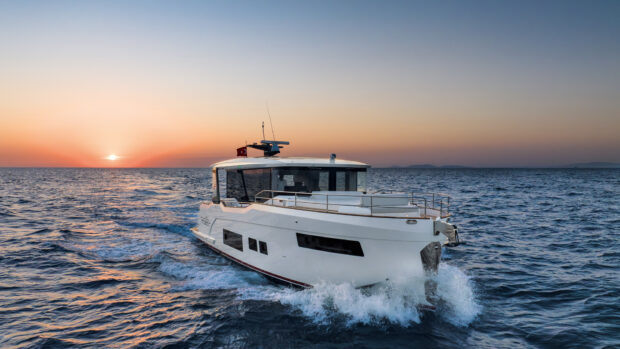More than just a simple upgrade on previous models, the Azimut 66 offers an innovative layout, cutting-edge construction and, of course, the finesse we expect from the Italian yard
The Azimut 66 replaces the yard’s existing 64 model, which in turn replaced the original 62.
Between them, Azimut sold over 300 units of the 62/64, making for one of the yard’s most successful model series ever.
With heady expectations to meet, Azimut has cleaned the slate and started again with the 66. It is not a mere upgrade of the 64, it is a brand new boat with an extra cabin, much improved deck spaces and a far more modern construction.

The flat foredeck is a styling cue but also adds to the feeling of safety when you’re right forward.
Ninety per cent of the moulding is done using vinylester resin infusion, though Azimut isn’t the only production yard doing this sort of thing.
Where the yard is ahead of the game, however, is in its utilisation of carbon fibre in the build.
We saw this in the 55S but with the 66 it’s taken to the next level to ensure that volume and deck space are maximised without compromising the driving experience.
The foredeck, flybridge structure, radar arch and hardtop are all reinforced with carbon fibre, the result being that the Azimut 66 is over 2ft longer than the yard’s own Magellano 66 but weighs nearly 4 tonnes less.
Above and beyond
The flybridge and foredeck are major improvements; the top deck is now 28m² and the layout is hard to improve, particularly the optional lounging area on the very aft section of the deck.
Usually here there is a choice between a sunpad, open deck space for a couple of sunloungers, or tender storage with a crane.
On the 66, Azimut has designed some stylish low-slung seating around a cocktail table so guests can sit in comfort enjoying the elevated views away from the cover of the hardtop.

The layout of the flybridge combines an excellent blend of dining, sunbathing and loafing space.
The boat we had on trial didn’t have this option and the flybridge felt less special for it.
There is, of course, another seating area amidships, opposite the wet-bar, focused more on dining and right forward, the twin helm is supplemented by a U-shaped seating area adjacent that guests can sit at while the boat is moving or use as a mini sunpad at anchor.
There isn’t a huge amount of out-and-out sunbathing space on the flybridge but that is more than made up for on the foredeck.
The arrowhead bow that has become a signature piece of Azimut design divides opinion stylistically, but it does increase the available space at the bow and make for a flat, safe area to crew and tend to the ground tackle.

The mirrored glass is an Azimut hallmark and helps to reduce UV damage.
The eight-person bench forward of the windscreen is separated from the four-person sunpad by a teak-laid walkway – not groundbreaking stuff in this market, but a big improvement over what the 64 offered.
The changes are less obvious in the saloon, where the amidships galley arrangement remains with the main dining area located handily opposite.
Whereas the 64 had a storage unit opposite the lounging area aft, the Azimut 66 has yet more seating to create a more sociable arrangement, though you do lose the useful cupboard storage.
To counter this, Azimut has worked more storage into the galley itself and created a handy little breakfast bar facing back into the galley opposite the helm.

The galley isn’t enormous but the space on offer is used well.
It may not have the single-level expansiveness of the Princess 68 or the saloon/cockpit connection of the aft-galley Prestige 680, but the styling and use of materials is effortlessly stylish and cool. It’s beautifully done.
In fitting four cabins within the 66’s lower deck, Azimut has had to be smart with the configuration.
The twin cabin on the starboard side, which has a pair of side-by-side berths and its own ensuite, eats into the floorspace of the master cabin so, to counter that, the bed in the master lies athwartships.
This is irregular and space down the left hand side of the boat is tight up against the ensuite bulkhead, but the positive result is that hull windows are at either end of the bed meaning you get light pouring over you from behind and water level views at the end of the bed.

The master ensuite is dripping with quality materials.
The ensuite – beautifully finished and doing a passable impression of a top-end hotel – runs alongside the bed and also provides some extra insulation from the machinery space right aft.
Between the twin cabin bulkhead and the large L-shaped wardrobe on the starboard side, Azimut has found space for a small two-person dinette, which is more likely to be used as a vanity station than a place to eat breakfast.
I love the way the bedhead is set within an alcove that has the portside hull window at its centre with uplighting and built-in bedside tables either side.
It hammers home the hotel feel – this is a space that feels not like a cabin but an exquisitely decorated bedroom.
If the VIP cabin is occupied then the twin cabin is a fine alternative.

The VIP cabin is treated to abundant natural light thanks to long windows.
It has the polished feel of the other cabins, two comfortable berths and a pair of almost ornamentally pretty round ports that fire natural light into the space to deceive the eye that it has more room than it does.
Mix in abundant storage and access to its own ensuite – albeit one that is also the day heads – and you have a cabin that guests will be more than happy to use for an extended stay.
There is only space in the fourth cabin for bunks, most likely aimed at kids, but the beds are spacious enough for adults to use and, for a charter boat, the four-cabin layout will be particularly attractive, especially with a generous twin crew cabin located aft.
First-class machinery
Venture into the engineroom and it’s clear that beneath the glamorous lines and mirrored glass there is top-class engineering and practical detailing.
The two big CAT motors are mounted with plenty of space around them to check all sides of both engines.
Piping is clearly labelled, not just with what it does but the direction of flow, too.
Clear bulbs on the fuel filters make checking for the early signs of fuel contamination as easy as possible and there are extra goodies, such as a light on a wandering lead and a freshwater hose to swill the bilges.

The master’s cosy dinette is a more useful solution than the usual chaise longue.
Glamorous this stuff ain’t but it underpins the Azimut 66’s style and panache and, for a boat that will most likely be owner-run, this sensible design and ease of maintenance is very important.
One of the reasons why Azimut chose Caterpillar engines is because spare parts are so readily available thanks to CAT’s massive commercial machinery business.
The C18 ACERT 1,150s are the only engines on the options list so if they underperform it spells trouble.
Thankfully, with nearly full fuel, a quarter water and some cruising stores on board, we saw just over 33 knots at the top end.
So performance isn’t an issue and neither is refinement.

The galley forward leaves plenty of space aft for a sociable lounge.
Azimut’s attitude to sound deadening is fastidious and the results are clear to see, or hear, especially from the lower helm.
It’s a whisper-quiet machine that effortlessly surges from displacement plod to planning jog in a near-imperceptible transition.
The fly-by-wire steering is perfectly judged, though its sensitivity and responsiveness can be adjusted by the owner.
It’s unlikely that many people will be tweaking the steering response of their 40-tonne flybridge, especially when the standard set-up is so sweet.
The Azimut 66 is genuinely fun to drive, which is not something in the remit of a boat like this, but if it puts a smile on your face as you flick the chunky steering wheel from side to side, all the better.

To allow space for the fourth cabin, the master berth runs athwartships.
Part of the steering system that Azimut has developed means that the rudders turn to a greater angle at low speeds to make the turn tighter.
Ferretti has been using a similar feature for some time now but Azimut’s works without the car-like auto-centre trick that the Ferretti version has and takes some getting used to.
At slow speeds, an integrated joystick system combines the engines and thrusters to give you IPS-like slow-speed control, and it works brilliantly.
The response and reaction times aren’t quite as quick and smooth as the pods but it’s a worthwhile alternative to the traditional way of handling a twin shaftdrive boat.

The large thick rimmed steering wheel looks and feels fantastic.
The lower helm is an attractive mix of coffee and caramel tones and with gorgeous, adjustable Treben helm seats and mercifully skinny windscreen mullions, the view forward is excellent.
The multi-function displays are both too much of a stretch, even with the seat as close to the dash as it will go, so you find yourself leaning forward a lot of the time.
At the upper helm, the screens are closer but the seats don’t adjust as far so there are compromises at both driving positions.

The upper helm lacks the adjustment of the one below but it is very clearly laid out and smartly finished.
Our test in Savona did little to test the mettle of the Studio PLANA hull design and any wake crossings were dismissed with a condescending shrug.
Given the solidity of the boat as a whole and Azimut’s reputation, I would be surprised if rough seas threw up any nasty surprises but we certainly didn’t have the weather to prove that during the sea trial.
A closer look at the Azimut 66 with Jack Haines
Breakfast bar
This neat area adjacent to the lower helm and facing into the galley works brilliantly as a spot to sit and chat to the cook or have a morning coffee, plus it gives guests a place to keep the person at the helm on passage company, though they will be facing the wrong way.
Glass act
Thanks to electrochromic glass, this partition in the galley switches from clear to opaque at the flick of a switch.
Whether you want privacy from crew or to hide piles of plates, it’s a useful feature, not to mention a funky party trick.
Crew cabin
With two generous berths set at a right angle and a separate bathroom with shower, the Azimut 66’s crew cabin could feasibly be used by guests – especially kids – for a short stay.
Sadly there isn’t space for an access door through to the engineroom, which would be useful for crewed boats.
Engineroom

The fuel filters have glass bowls for quick checks.
Behind the swooping lines and mirrored windows you find an engineroom bristling with thoughtful, practical design.
The fuel filters have glass bowls for quick checks, all pipes and wires are labelled with what they do and, for pipes, direction of flow, plus there is a light on a wandering lead and a freshwater hose.
Azimut 66 verdict
Sales success isn’t exactly a scientific way of quantifying how good a boat is. Brand loyalty goes a long way, as does an individual deal negotiated with a dealer, but for 35 contracts to have been signed since January 2016 and 15 boats delivered, Azimut must be doing something right.
As an improvement over the model it replaces, you couldn’t ask for more.
It has one more cabin, a much-improved foredeck, larger, better laid-out flybridge and a more spacious master cabin.
It is heavier, yes, but, thanks to the carbon fibre, with the same engines as the 64, it is only a knot slower at the top end.
The Azimut 66 finds itself somewhere between the Princess 68 and Prestige 680 when it comes to starting prices and that feels about right.
The 68 demands a premium as it includes four cabins without the compromise of one of them having bunk beds.

The fixed comfortable furniture aft on the flybridge is a rare treat.
The Prestige has a clever layout and marvellous raised master cabin forward but the use of materials isn’t as good as the Azimut and it lacks the visual punch.
In fact, most of the Azimut’s major rivals bow down to its attention-grabbing exterior and interesting lines.
What’s key though, is that the Azimut 66 isn’t simply relying on looking different to tempt customers away from other brands.
Beneath the glitz and glamour is a boat rippling with top-class engineering and quality boatbuilding, a recipe that is likely to see this new model tread comfortably in its predecessor’s footsteps.
First published in the March 2017 issue of MBY.
Details
Price from: €2.15m inc VAT
Price as tested: €2.48m inc VAT
Hardtop with sunroof (Options on test boat): €61,980
Raymarine gold package (Options on test boat): €32,657
Bose audio/video advanced package (Options on test boat): €57,626
Hydaulic passerelle (Options on test boat): €23,924
Electric bimini on foredeck (Options on test boat): €19,865
Overal length: 68ft 3in (20.8m)
Beam: 17ft 2in (5.23m)
Fuel Capacity: 858 imp gal (3,900 litres)
Water Capacity: 220 imp gal (1,000 litres)
Draught: 5ft 3in (1.6m)
RCD Category: A for 14 people
Designers: Stefano Righini/Carlo Galeazzi/Studio PLANA
Displacement: 41 tonnes
Test engines: Caterpillar C18 ACERT Twin 1,150hp @ 2,400rpm. 6-cylinder, 18.1-litre diesels











